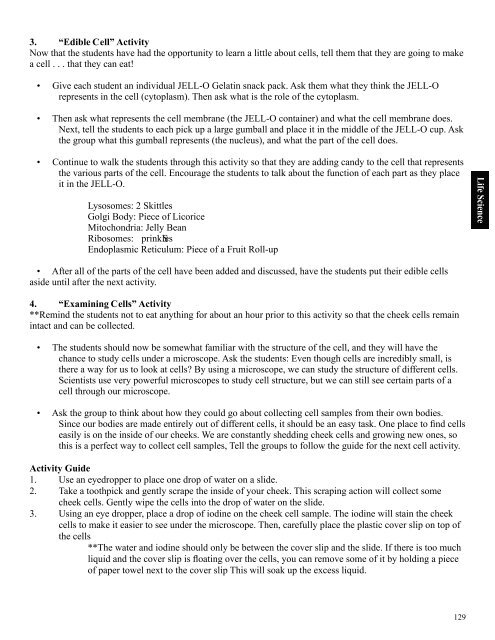ScienceMakers Toolkit Manual - The History Makers
ScienceMakers Toolkit Manual - The History Makers
ScienceMakers Toolkit Manual - The History Makers
You also want an ePaper? Increase the reach of your titles
YUMPU automatically turns print PDFs into web optimized ePapers that Google loves.
3. “Edible Cell” Activity<br />
Now that the students have had the opportunity to learn a little about cells, tell them that they are going to make<br />
a cell . . . that they can eat!<br />
• Give each student an individual JELL-O Gelatin snack pack. Ask them what they think the JELL-O<br />
represents in the cell (cytoplasm). <strong>The</strong>n ask what is the role of the cytoplasm.<br />
• <strong>The</strong>n ask what represents the cell membrane (the JELL-O container) and what the cell membrane does.<br />
Next, tell the students to each pick up a large gumball and place it in the middle of the JELL-O cup. Ask<br />
the group what this gumball represents (the nucleus), and what the part of the cell does.<br />
• Continue to walk the students through this activity so that they are adding candy to the cell that represents<br />
the various parts of the cell. Encourage the students to talk about the function of each part as they place<br />
it in the JELL-O.<br />
Lysosomes: 2 Skittles<br />
Golgi Body: Piece of Licorice<br />
Mitochondria: Jelly Bean<br />
Ribosomes: prinkles S<br />
Endoplasmic Reticulum: Piece of a Fruit Roll-up<br />
• After all of the parts of the cell have been added and discussed, have the students put their edible cells<br />
aside until after the next activity.<br />
4. “Examining Cells” Activity<br />
**Remind the students not to eat anything for about an hour prior to this activity so that the cheek cells remain<br />
intact and can be collected.<br />
• <strong>The</strong> students should now be somewhat familiar with the structure of the cell, and they will have the<br />
chance to study cells under a microscope. Ask the students: Even though cells are incredibly small, is<br />
there a way for us to look at cells? By using a microscope, we can study the structure of different cells.<br />
Scientists use very powerful microscopes to study cell structure, but we can still see certain parts of a<br />
cell through our microscope.<br />
• Ask the group to think about how they could go about collecting cell samples from their own bodies.<br />
Since our bodies are made entirely out of different cells, it should be an easy task. One place to fi nd cells<br />
easily is on the inside of our cheeks. We are constantly shedding cheek cells and growing new ones, so<br />
this is a perfect way to collect cell samples, Tell the groups to follow the guide for the next cell activity.<br />
Activity Guide<br />
1. Use an eyedropper to place one drop of water on a slide.<br />
2. Take a toothpick and gently scrape the inside of your cheek. This scraping action will collect some<br />
cheek cells. Gently wipe the cells into the drop of water on the slide.<br />
3. Using an eye dropper, place a drop of iodine on the cheek cell sample. <strong>The</strong> iodine will stain the cheek<br />
cells to make it easier to see under the microscope. <strong>The</strong>n, carefully place the plastic cover slip on top of<br />
the cells<br />
**<strong>The</strong> water and iodine should only be between the cover slip and the slide. If there is too much<br />
liquid and the cover slip is fl oating over the cells, you can remove some of it by holding a piece<br />
of paper towel next to the cover slip This will soak up the excess liquid.<br />
129<br />
Life Science










